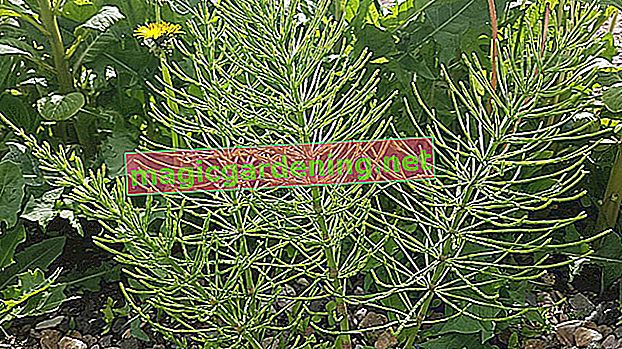
That's why horsetail is so stubborn
Horsetail is one of the oldest plants in the world. Over the millennia, the plant has developed mechanisms to survive even under adverse conditions. It tolerates waterlogging, grows particularly well on compacted soils and is incredibly vigorous.
also read
- Fight brown ella permanently in the lawn
- Plant horsetail in the garden
- Horsetail in the garden - the gardener's horror
Horsetail propagates in two ways. On the one hand, horsetail forms rhizomes that produce runners. They grow both vertically in depth and horizontally in width. The shoots become several meters long, so that they can even grow under houses.
On the other hand, horsetail does not reproduce via seeds. The plant does not form flowers, but spur ears. The spores are spread everywhere by the wind in spring.
Natural means of killing horsetail
- Green manure
- Apply drainage
- Liming the ground
- Loosen the soil
- Sieve out the root remains
- Take off horsetail
- cut off spore ears in spring
All the natural means you use to destroy horsetail are aimed at loosening the soil and preventing the soil from becoming too moist. Horsetail does not like drained and loose soils.
To loosen the soil, sow a green manure. Lupins get very long roots and are therefore particularly suitable. The roots stay in the soil and decompose there, making the soil permeable to water.
Liming green manure and soil
Horsetail does not like dry soil. Make sure that rain and irrigation water can easily seep into the ground. In the case of very dense, heavy soils, you should always create drainage before creating beds or sowing lawns.
Horsetail loves acidic soils. If there is a lot of horsetail, check the acidity of the soil. If it's too mad, you can whitewash it. This noticeably slows the rapid growth of horsetail.
Manual work is required
The most effective way to destroy horsetail is to dig up the rhizomes. However, this is not so easy because of the depth of the roots. Not even removing the topsoil and backfilling it always helps.
However, you can curb the growth of horsetail a little if you loosen the soil deeply, collect all the rhizomes and then sift through the soil several times. Smaller root remains can also be removed from the earth.
Always use a digging fork when digging. With a spade you only prick the rhizomes and runners into even more parts. A new plant can grow from each individual part.
What helps in removing horsetail in the lawn?
Horsetail in the lawn is a real nuisance, because you can hardly get rid of it without completely removing the lawn and sowing it again.
It is helpful to scarify the lawn in spring. This strengthens the grass plants and forms denser carpets, which make it a little heavier for the horsetail. Don't cut the grass too short so that the ground remains shaded. If the soil is very acidic, lime it. This also helps to strengthen the grass.
Some gardeners swear by darkening the lawn. A foil is placed over the affected areas and left there for some time. The lawn will turn brown in these areas, but it usually recovers very quickly. This measure can be worth trying before removing and re-laying the entire lawn.
Eliminate horsetail with a weed killer
The use of weed killers is pointless with horsetail. Chemical agents work on the surface. Since the roots of horsetail run very deep, the poison does not reach them.
It is therefore better not to use weed killers at all, as they will hardly have any effect and instead damage all other plants and the garden beneficiaries.
Plant horsetail in the pot
Horsetail is valued in naturopathy and cosmetics. As horsetail manure, it is a very good fertilizer and as a broth it works against powdery mildew on roses.
If you want to plant horsetail in the garden to have a supply, it is better to care for the horsetail in the bucket. Then it cannot spread through the rhizomes in the garden.
You should always cut off the spore ears as soon as you discover them. Horsetail remains - whether spores or roots, do not belong on compost. Destroy the leftovers by disposing of them through the garbage disposal.
Tips
There are some home remedies that are recommended for getting rid of horsetail, such as pouring hot water over the area or sprinkling the horsetail with salt or vinegar. These measures can help for a short time - you will not permanently remove horsetail.








